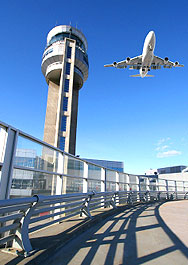Strong tailwind favours Indian aviation
20 Jan 2007
 The government's unrelenting emphasis on regulatory reforms and stepped-up investment on aviation infrastructure have added to the impetus. The aviation sector, which grew 25 per cent in 2005-06, is expected to expand 25 per cent annually for the next five years.
The government's unrelenting emphasis on regulatory reforms and stepped-up investment on aviation infrastructure have added to the impetus. The aviation sector, which grew 25 per cent in 2005-06, is expected to expand 25 per cent annually for the next five years.
Inaugurating the India-EU aviation summit on Nov 23, 2006, the minister for civil aviation, Praful Patel, said that the growth witnessed in the sector was likely to continue. "This year the growth in domestic air travel has been 50 per cent while in international air travel, it has been 25 per cent. These are not the kind of figures that will slow down. In the next 10-year horizon the sector is expected to grow at around 25 per cent annually," the Minister said.
Domestic airlines now have permission to fly to international destinations, and the Indian ministry of civil aviation has recently announced plans to modernise 35 airports over the next five years. This will entail investments of over $ 3.5 billion, offering a huge opportunity to airport service and equipment suppliers.
In the first 11 months of the year to November 2006, India's airlines carried nearly 29 million domestic passengers, clocking growth of 47 per cent over the corresponding period of 2005. The boom in passenger traffic reflects the increase in scheduled domestic air services, which are now available from 75 destinations in the country, against about 50 in the year 2000.
Not surprisingly, Indian carriers are expected to buy close to 480 aircraft over the next twenty years. Boeing forecasts project India's total fleet strength to grow to 492 aircraft, involving investments of over $36 billion up to 2024.
There is already a crunch. There are reports that India's public sector international carrier Air India is being forced to lease up to 12 long-and-medium haul aircraft as a short-term measure to overcome the shortage of aircraft. The airline has already placed an order for 68 new Boeing aircraft in 2005.
The directorate general of civil aviation (DGCA) is reportedly considering reducing the period for acquiring a commercial pilot licence (CPL) from 16 to 12 months. It is also considering the grant of CPLs to about 250 foreign pilots in the first quarter of 2007. Also on the cards is the acquisition of additional trainer aircraft, for which the DGCA has invited expressions of interest from foreign companies to build a new pilot training institute.
The creation of maintenance, repair and overhaul services and the modernisation and expansion of the airport infrastructure are also moving ahead at full throttle.
Infrastructure development
The Airports Authority of India (AAI) is the principal agency for the development and maintenance of aviation infrastructure facilities in India. Formed on 1 April 1995 through the merger of the International Airports Authority of India and the National Airports Authority, the AAI is entrusted with the task of accelerating the integrated development, expansion and modernisation of the operational, terminal and cargo facilities at airports in conformity with global standards.
The AAI manages 94 civil airports, including 9 international airports at Kolkata, Chennai, Thiruvananthapuram, Bangalore, Hyderabad, Ahmedabad, Goa, Amritsar and Guwahati and 28 civil enclaves at defence airfields. In 2006 it ceded a majority stake in the modernisation, expansion and running of the Delhi and Mumbai international airports to joint ventures in which it has retained a 26 per cent stake.
Growth in economy
While cargo carried by the aerial route weighs less than 1 per cent of the total cargo exported from India, it accounts for 35 per cent of the total value of the country's exports. Better cargo handling facilities lead to enhanced levels of importation, especially of capital goods and high-value items. Also, 97 per cent of the country's foreign tourists arrive by air; tourism is today the nation's second largest foreign exchange earner.
Given its importance, the Indian government is developing a policy framework for the entire civil aviation sector. The objectives of the policy are:
| | to boost international trade and tourism and improve the country's image; |
| | to provide airport capacity ahead of demand, in order to handle an increasing volume of air traffic and to expand India's share in the travel and tourism market in the region; |
| | to make airports more customer-friendly and improve customer satisfaction. |
| | to ensure total safety and security of aircraft operations by introducing state-of-art air traffic, security and related services; |
| | to provide multi-modal linkages; |
| | to provide a market orientation to the present structure, bridge the resource gap and encourage greater efficiency and enterprise in the operation of airports through the introduction of private capital and management skills; |
| | to develop airport infrastructure across the country, including in remote and inaccessible areas, especially in the north east of the country, and in the hilly and island regions; and |
| | to encourage transparency and clarity in the decision-making processes of the government and its public sector units. |
The government is also planning to merge Air India with Indian to create a more viable entity. Besides having a fleet of 120 aircraft, the proposed entity will have a workforce of 33,000 and a combined turnover of $4 billion.
The expansion of air transport in India is among the fastest in the world. With increasing globalisation, this sector will continue to play a significant role in integrating the Indian economy with the rest of the world.






























